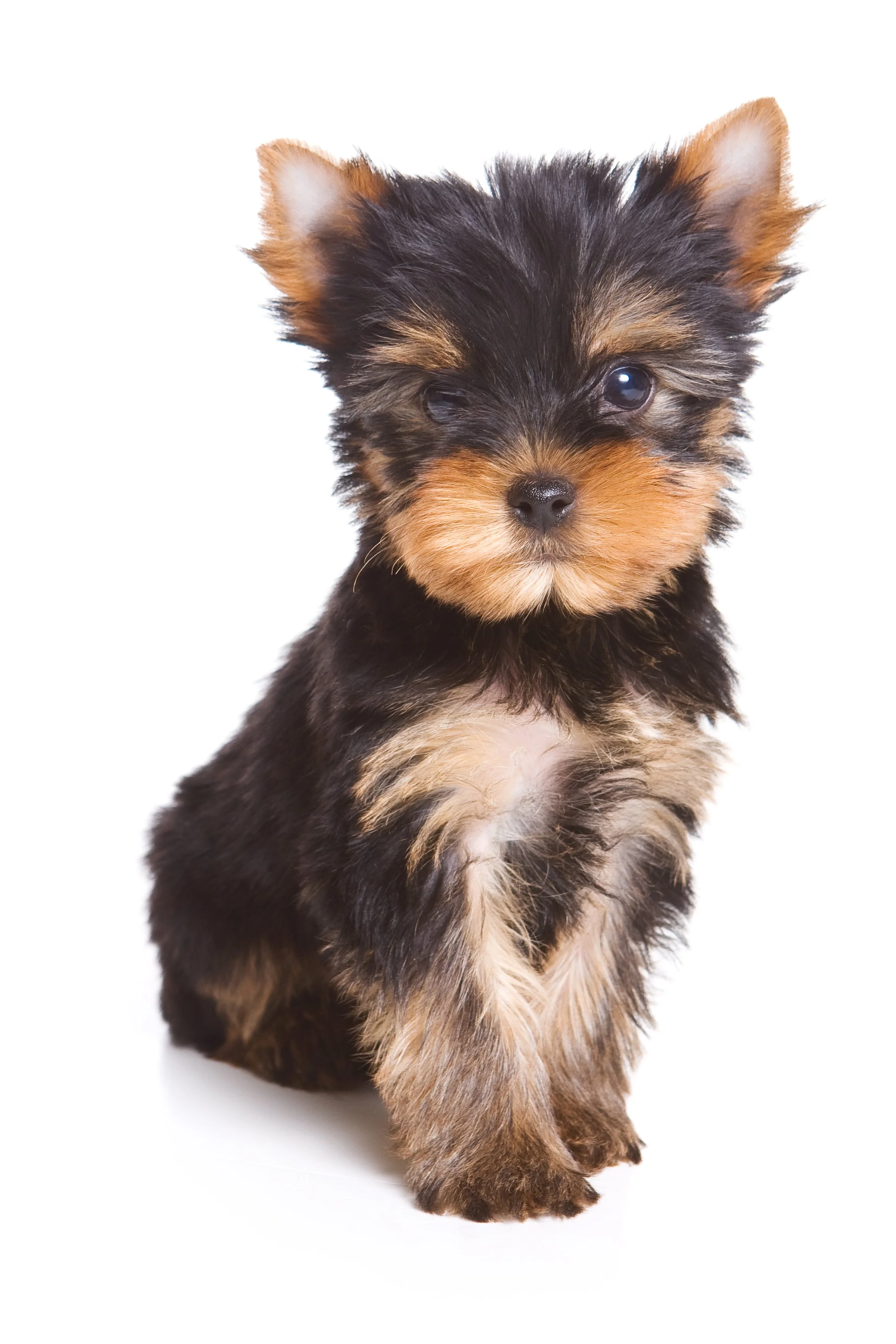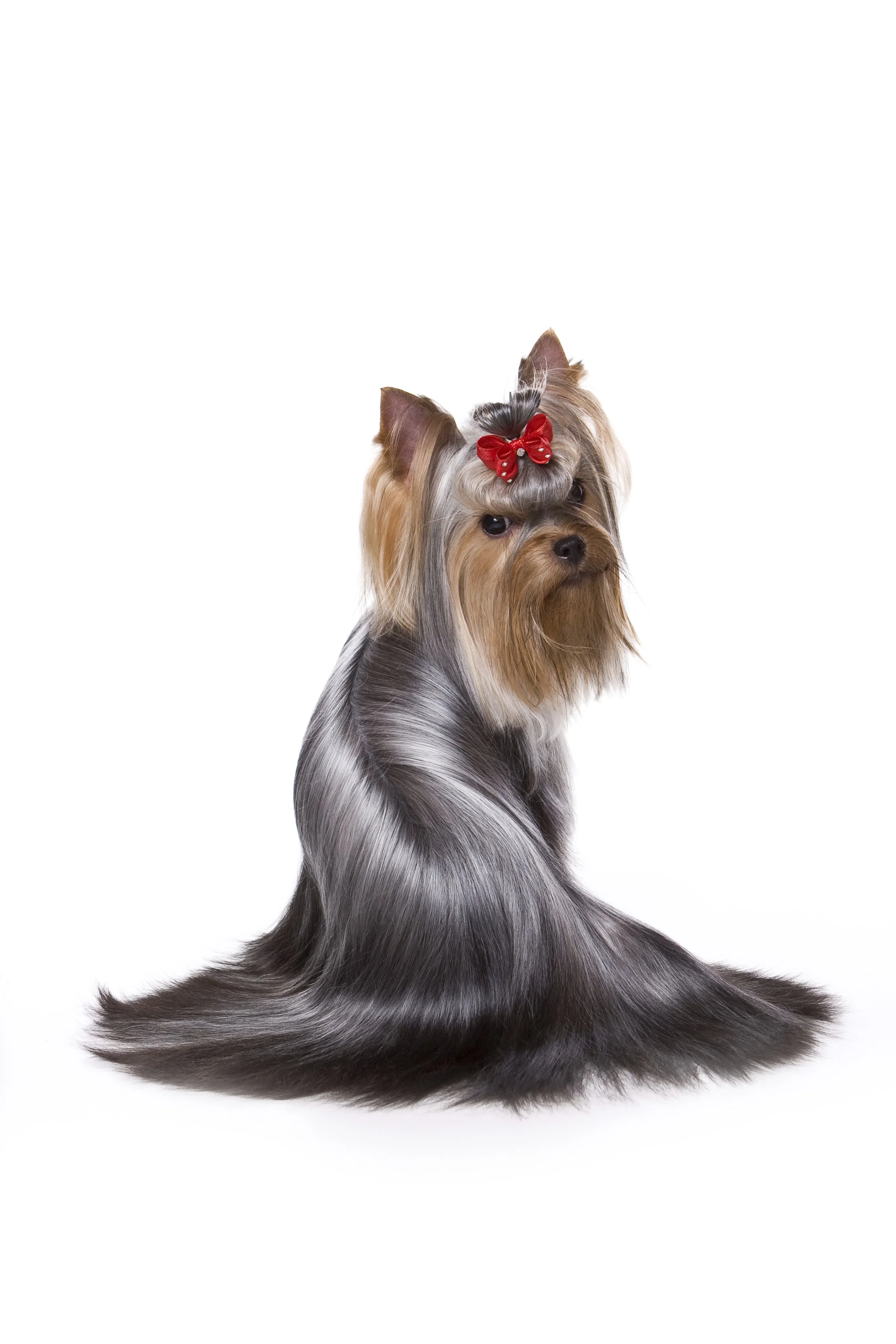About Yorkies
Official Standard
General Appearance
That of a long-haired toy terrier whose blue and tan coat is parted on the face and from the base of the skull to the end of the tail and hangs evenly and quite straight down each side of body. The body is neat, compact and well proportioned. The dog's high head carriage and confident manner should give the appearance of vigor and self importance.
Head
Small and rather flat on top, the skull not too prominent or round, the muzzle not too long, with the bite neither undershot nor overshot and teeth sound. Either scissors bite or level bite is acceptable. The nose is black. Eyes are medium in size and not too prominent; dark in color and sparkling with a sharp, intelligent expression. Eye rims are dark. Ears are small, V-shaped, carried erect and set not too far apart.
Body
Well proportioned and very compact. The back is rather short, the back line level, with height at shoulder the same as at the rump.
Legs and Feet
Forelegs should be straight, elbows neither in nor out. Hind legs straight when viewed from behind, but stifles are moderately bent when viewed from the sides. Feet are round with black toenails. Dew claws, if any, are generally removed from the hind legs. Dew claws on the forelegs may be removed.
Tail
Docked to a medium length and carried slightly higher than the level of the back.
Coat
Quality, texture and quantity of coat are of prime importance. Hair is glossy, fine and silky in texture. Coat on the body is moderately long and perfectly straight (not wavy). It may be trimmed to floor length to give ease of movement and a neater appearance, if desired. The fall on the head is long, tied with one bow in center of head or parted in the middle and tied with two bows. Hair on muzzle is very long. Hair should be trimmed short on tips of ears and may be trimmed on feet to give them a neat appearance.
Colors
Puppies are born black and tan and are normally darker in body color, showing an intermingling of black hair in the tan until they are matured. Color of hair on body and richness of tan on head and legs are of prime importance in adult dogs, to which the following color requirements apply: BLUE: Is a dark steel blue, not a silver blue and not mingled with fawn, bronzy or black hairs. TAN: All tan hair is darker at the roots than in the middle, shading to still lighter tan at the tips. There should be no sooty or black hair intermingled with any of the tan.
Color on Body
The blue extends over the body from back of neck to root of tail. Hair on tail is a darker blue, especially at end of tail.
Head fall
A rich golden tan, deeper in color at sides of head, at ear roots and on the muzzle, with ears a deep rich tan. Tan color should not extend down on back of neck.
Chest and Legs
A bright, rich tan, not extending above the elbow on the forelegs nor above the stifle on the hind legs.
Weight
Must not exceed seven pounds.
Disqualification
Any solid color or combination of colors other than blue and tan as described above. Any white markings other than a small white spot on the forechest that does not exceed 1 inch at its longest dimension.
Approved April 12, 1966 DQ added Oct. 1, 2007
History
Read information on the history of the breed.
Grooming the Yorkshire Terrier
Grooming a Yorkie involves not only taking care of the coat, but taking care of the whole Yorkie. We're going to start with the coat and then go into other areas.
Any hair type grows best when the Yorkie is in good health and being fed a correct diet. Everyone hears about the Yorkie's silk coat. What is meant by that is that it has one layer and no undercoat making it very similar to human hair strands. The correct coat will have a deep shine in the sunlight that will reflect like metal. Unfortunately, not every Yorkie will inherit the correct coat and you will find them cotton, woolly or double coated at times.
The cotton coat is fine, will mat easily and is not an easy coat to grow out. The usual cotton coat will be lighter in shade and you will get two colors but the called for shaded tans will instead be an almost pale blonde and the called for dark blue will be lighter gray but with a blue shade many times to it. A daily brushing will help this coat as will using a conditioner with a slight oil base. Many people find the easiest is to cut this coat into one of the many clipped coat styles.
The woolly coat is thick, full and typically very dark, many times never turning the correct Yorkie colors. The head and legs will usually have dark hairs intertwined with the shaded tan. Sometimes the dog will lighten to a gray but it too will never reflect the metallic sheen of the correct coats. This coat must be brushed once or twice a day to prevent matting and is highly recommended that it be kept in one of the numerous trims for Yorkies for ease of handling.
Cleanliness is very important as dirty hair cannot grow well. The Yorkie should be bathed once every week or two. Some need a bath more often than others. Any good dog shampoo is recommended along with a good conditioner.
First make sure you have all the tangles out of the coat. A wide tooth metal comb is good for this along with a good brush. Don't pull mats out, gently work them out with your fingers first and then the comb. Always work from the ends of the hair to the part closest to the body. A little detangler on the mat will make it easier to get out and also save coat. A good brushing every day keeps the tangles away.
When all the tangles are out, then shampoo and rinse. After you have rinsed, rinse again to make sure every bit of soap is out of the coat. Left in, it will dull the coat and might cause itching. Then use a good conditioner. A small sponge works really well for rinsing the face so as not to get water in their nose and mouth.
While your Yorkie is in the bath, this is the time to check the anal glands. There are two of them, one on each side of the anus. They only need to be expressed if they are full. You might need your vet to show you how. Clip the hair right around the edge of the anus for a cleaner Yorkie and to keep him from getting stopped up.
The corners of the eyes should be cleaned every day if your Yorkie tears a lot. Some Yorkies tear more than others and cleaning this area will help prevent staining around the eyes. Tears will also cause the whisker hair to rot.
The ears of most Yorkies are considered prick, which means they stand up on their own. Always use care with your Yorkies ears and do not use cotton swabs etc. If need be, use a good ear flush or powder. A dog's ear canal curves into the head which is why using q-tips or swabs are not recommended. Any unusual smell about the ear or continued scratching should be checked by a qualified veterinarian.
The hair on the Yorkies ears are shaved 1/3 down from the tip. The hair on the pads of his feet should be kept clipped so he does not slip on slippery floors. Trim around his feet and coat as needed.
For clean, white teeth and sweet smelling breath, clean your Yorkie's teeth every day. It can be handled in numerous ways from the pet toothbrushes and tooth pastes on the market, to pretreated pads, to using a gauze pad wrapped around the finger. Gently wipe or brush the teeth front and back. Done daily you will find that the teeth stay much cleaner and healthier for years. Your veterinarian can recommend the best toothpaste to use. If the teeth get too dirty, you will need to have them cleaned by your veterinarian.
Toenails should be cut regularly, at least every two weeks. If cut at the curve they should not bleed and if cut on an angle like the natural wear of the nail, it will help keep the cuticle back.
Keep your Yorkie flea free. One flea can ruin a Yorkie's coat. Make sure you check for fleas, and ticks as well, since these and other bugs can cause skin irritation and extreme scratching which can inflame and infect the skin. Check the ears, under the legs and around the neck and chest area when grooming.


